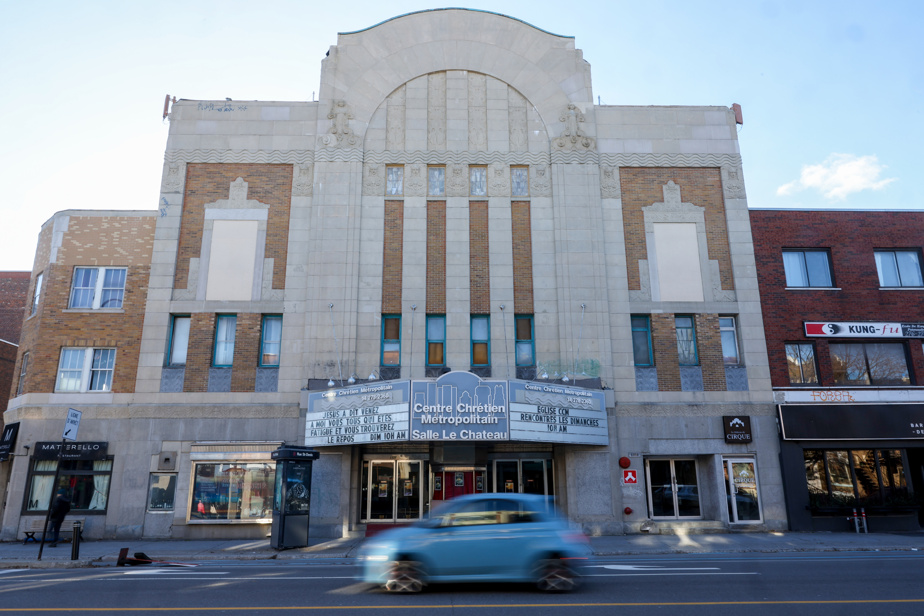Sunday afternoon in December. After multiple unanswered calls to the owners, we dared to walk through the doors of 6956, rue Saint-Denis. Upstairs, no doubt: we are in an old cinema room. However, between the stage and the rows of seats, acrobats jump on trapezes. This is normal since we are in the premises of the Château de cirque school, formerly called Trapézium.
On the ground floor, there is the big Sunday meeting of the Metropolitan Christian Center community, but we will not be able to go further than the entrance hall.

PHOTO FRANÇOIS ROY, THE PRESS
The premises of the Château de cirque school
The former Le Château cinema is one of the best preserved “neighborhood palaces” in Montreal. While strolling rue Saint-Denis or rue Bélanger, very close to the Jean-Talon market, you can still admire the facade of the listed heritage building.
However, these are not the films that are showing on the marquee. It reads: “Jesus said come to me, all you who are tired and you will find rest.”

PHOTO FRANÇOIS ROY, THE PRESS
The Metropolitan Christian Center did not respond to our calls.
Several old cinemas have been converted into places of worship throughout Quebec, underlines Pierre Pageau, author of the book Cinemas in Quebec: 1896-2008. Further north, at 8610, rue Saint-Denis, just south of the Métropolitaine highway, this was also the case for the former Crémazie cinema.
From “scope” cinemas to palaces
Around 1915, “scope” type cinemas with around 200 seats began to give way to more luxurious and larger establishments: “palaces”.

PRESS ARCHIVES
The old Château cinema
The Château opened in 1932. It was a “neighborhood palace” type cinema. It was practically next door to another cinema, Le Rivoli, which had some 1,500 seats (today occupied by a branch of Pharmaprix). “The phenomenon of twin cinemas, which I call bessons, was very common at the time,” underlines Pierre Pageau. At the corner of Sainte-Catherine Street and Saint-Laurent Boulevard, for example, we found the Crystal and Midway cinemas practically “glued together”.

PHOTO TAKEN FROM THE MONTREAL ARCHIVES WEBSITE
The Midway and the Crystal: two cinemas next to the Hand
In Rosemont–La Petite-Patrie, we also find not far from the Château and the Rivoli, on rue Saint-Hubert, another cinema, the Plaza theater, opened in 1922. The Beaubien cinema will open its doors later, in 1937 .
Confederation Amusements Limited owned the Château and also the Outremont Theater. The two Art Deco style rooms are the work of the architect René Charbonneau and the great decorator Emmanuel Briffa. The latter has left its mark on more than 150 cinemas in North America, including the Empress, the Rivoli, the Rialto and the Snowdon Theater.

PHOTO FRANÇOIS ROY, THE PRESS
Photo of the interior of the old Le Château cinema taken by Simon Edelstein for the book The twilight of the cinemas (Éditions Jonglez), published in 2021.
In 1937, there were 59 cinemas in Montreal. After the palaces – which will be divided – more modest theaters like the Paris Cinema will be built. The arrival of television will change people’s habits, so much so that cinemas will focus their programming with repertory or… erotic films!

PHOTO FRANÇOIS ROY, THE PRESS
During his career at Ahuntsic College, Pierre Pageau taught Jean-Marc Vallée, Émile Proulx-Cloutier and photography director Michel La Veaux.
The Château is one of the many cinemas which presented daring films in the 1970s, underlines Pierre Pageau. It closed in 1982 to reopen under the name Espace 9.
It will notably present Disney films and The tuque warbut the projections ceased in 1985, and the building was acquired in 1989 by the Metropolitan Christian Center.
As for the Rivoli, it closed its doors in 1982.

PHOTO FRANÇOIS ROY, THE PRESS
A Pharmaprix occupies the former Rivoli Theater at 6919, rue Saint-Denis.
In the 1980s, more theaters closed than opened. “In 1983 Super Écran arrived. For the first time, you can tune into a television set that only shows films. »
Today, Pierre Pageau emphasizes that we are witnessing a renaissance of “small theaters of Quebec films and repertoire”. He cites the Moderne and Public cinemas, and Station Vu, for which he is responsible for programming.
Who knows, maybe the days when “cinemas were at the center of everything” will return.
Read next week: the condos of the former Snowdon Theater
